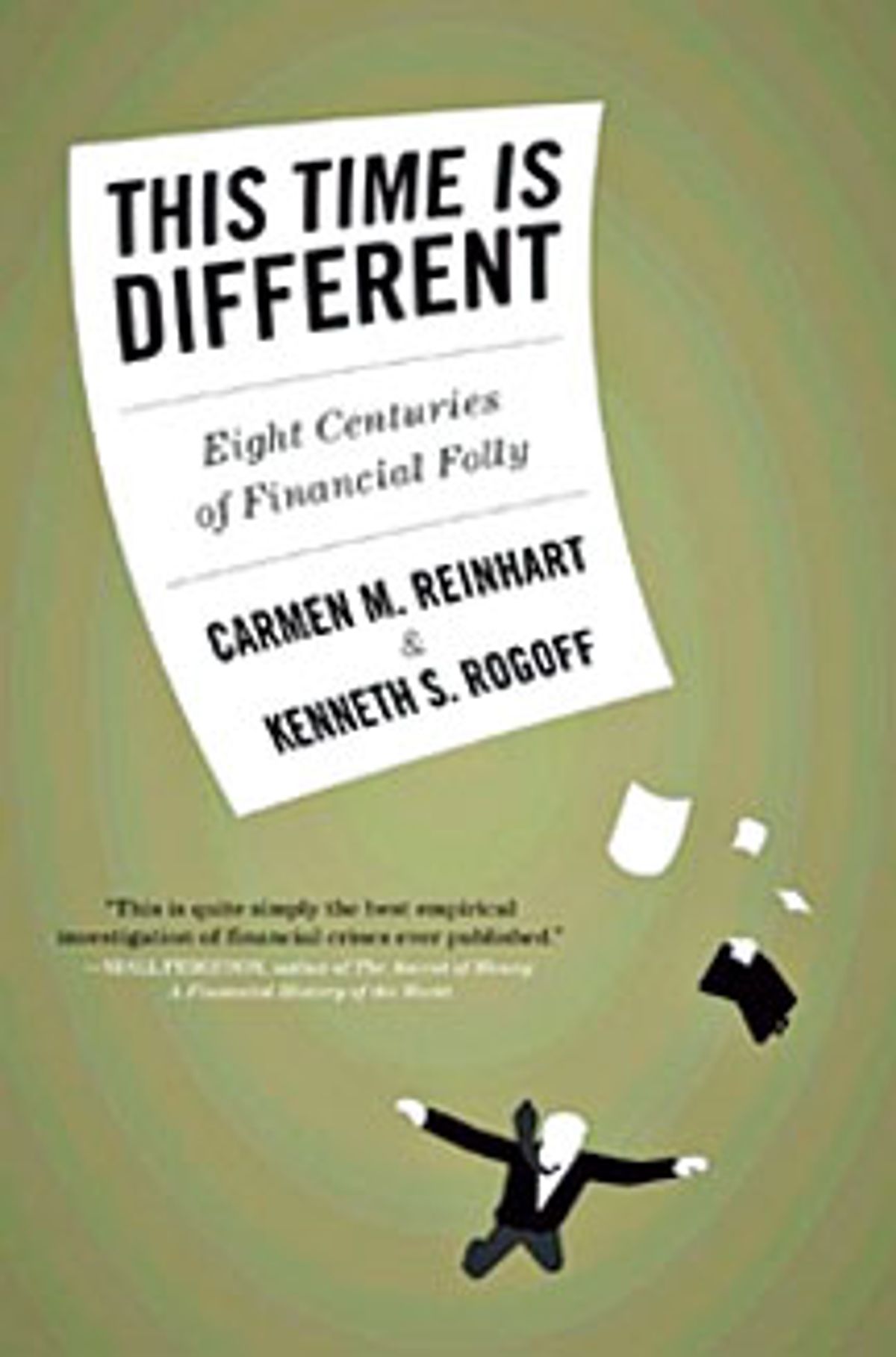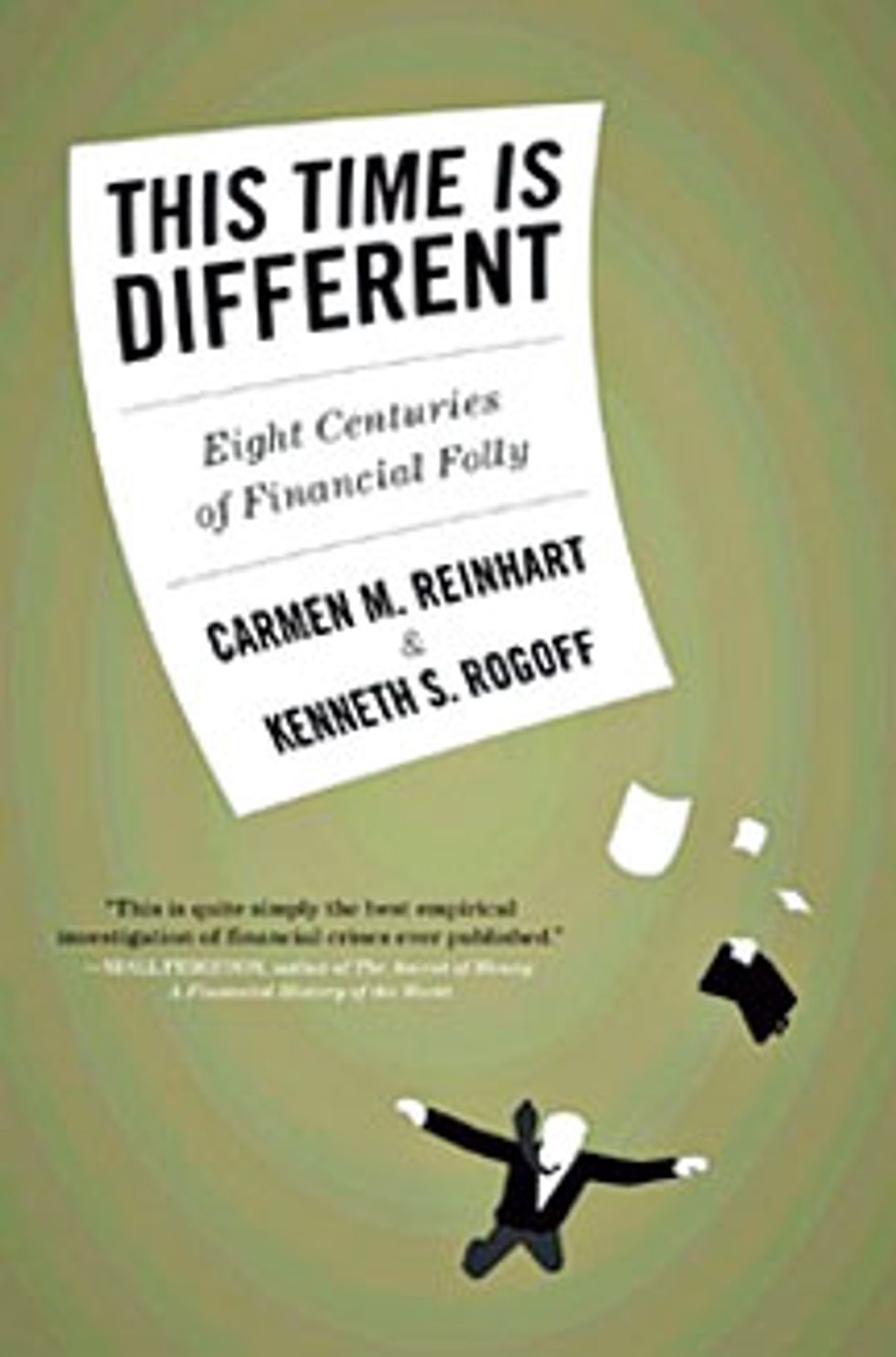Reviewed by Andrew M. Odlyzko
By Carmen M. Reinhart & Kenneth Rogoff; Princeton University Press, 2009; 496 pp. (hardcover); US $35; ISBN 978-0-691-14216-6
Carmen M. Reinhart and Kenneth Rogoff’s 2009 book, This Time Is Different: Eight Centuries of Financial Folly, was a surprise best seller, but it would be even more surprising if most buyers got much further than the well-written preface and preamble. Not because the book is uninteresting or unimportant—it’s a significant work that should be on the desk of every venture capitalist, economic policymaker, and financial regulator.
The problem is the next 200 pages, which contain a scholarly but tedious discussion of sources and a taxonomy of financial crises. The general reader would be well advised to jump to the 100 pages starting with Chapter 13, which concentrate on the current crisis and the authors’ assessment, based on the historical evidence, of how it will develop.
Other books on bubbles, such as Edward Chancellor’s Devil Take the Hindmost: A History of Financial Speculation (1999) and Charles P. Kindleberger and Robert Z. Aliber’s Manias, Panics, and Crashes: A History of Financial Crises (5th ed., 2005), are qualitative, concentrating on a few huge bubbles and describing the amusing events and the general patterns that are visible in those episodes of investor exuberance. They can easily (if mistakenly) be read as supporting the popular view that financial crashes are rare. Reinhart and Rogoff, on the other hand, break new ground in providing a quantitative study of financial crises. And by collecting information on a world scale, and over centuries, they instead show conclusively that such crises have occurred with high frequency. They also demonstrate that the still-current economic crisis is in many ways typical in regard to how the bubble developed, how it crashed, how it is deflating, how it damaged the economy, and how most authorities (in government, the finance industry, and academia) refused to heed the plentiful warning signs, and instead believed that "this time is different."
The sudden change in fortunes in 2008, from a seemingly glowing prosperity to a crash, is also typical. As the authors write, "a highly leveraged economy can unwittingly be sitting with its back at the edge of a financial cliff for many years before chance and circumstance provoke a crisis of confidence that pushes it off."
Among their many fascinating findings, Reinhart and Rogoff note that while countries tend to "graduate" out of the pattern of defaulting on their foreign debts as they become richer, banking crises occur with similar frequencies in rich and poor countries. "Indeed," they write, "the tally of crises is particularly high for the world’s financial centers: France, the United Kingdom, and the United States." Further, extended lulls in crises have occurred a number of times, only to be followed by new outbreaks.
As valuable as this book is, I hope it is only the first of many in this area. Its statistical depth, while extensive by contrast to others in its genre, is still meager compared to what is needed for a deeper understanding of crashes. Even today many key indicators (such as the level of total indebtedness of a government, or of society as a whole) are not collected, and for most nations, the past century or two are an economic black box.
The vast majority of the data in the book are, as is to be expected in such an extensive collection, taken from other sources, and are occasionally wrong. Thus, for example, a table on page 112 describes the years 1749, 1822, 1834, and 1888–1889 as "episodes of domestic debt default or restructuring" in the UK, with the comment that "these were among several conversions of debt into lower coupon rates." While the comment is correct, these were neither defaults nor restructurings. British government debt (the famed "consols" and similar bonds) was callable (as are most corporate bonds in the United States today). When interest levels dropped, investors were offered a choice of lower-coupon debt or cash. These were entirely legal and predictable operations and were in fact associated with periods of prosperity, not of crisis.
There are also more serious limitations to This Time Is Different (though it should be noted that limitations are not defects; the scope of any scholarly work is necessarily limited). The statistics collected here show wide variation in various measures of economies on the brink of collapse, and we must proceed cautiously before drawing out generalizations.
Thus, for example, one ought not conclude, as some commenters have, that nations face serious peril when government debt reaches 90 percent of gross domestic product—such a sign should be regarded as yellow, but not necessarily red. The United States at the end of World War II had debt far in excess of that limit. And Britain at the end of the Napoleonic wars had debt more than twice its GDP and a crushing tax burden, yet it not only managed to avoid default but led the world into the Industrial Revolution. Far more research is called for on how countries navigate safely through such dangers.
This magazine’s readers are likely to be especially sensitive to another key limitation of the book: The authors disregard technological innovations, such as those of the Industrial Revolution. The focus is on financial crises, especially that of 2008, when the banking system appeared to be on the verge of collapsing. The authors are very explicit about this, and justify it on the grounds that damage to the system that moves money from savers into investments is what causes the greatest long-lasting damage to the economy. The only mention of the Internet bubble, for example, is at the end of the preamble, where the authors write: "Although technology stocks soared and collapsed, the effect on the real economy was only the relatively mild recession of 2001. Bubbles are far more dangerous when they are fueled by debt, as in the case of the global housing price explosion of the early 2000s."
This is true. Yet from some points of view, it is technomanias that are the most interesting, as they often lead to growth and prosperity, more often, it seems, than "financial innovations," which far more frequently are used for obfuscation and swindling. Fair disclosure: I am biased on this topic and working on a book comparing the Internet bubble to the British Railway Mania of the 1840s (on which I have published several papers).
It is easy to argue that many technology manias have been beneficial to society, even as they ruined investors. There is even one mania, the giant and wildly speculative railway craze in mid-1830s England, from which not only the nation gained but so did investors, who in the end reaped above-market returns. Yet in This Time Is Different the three great railway manias in Britain (of the mid-1830s, late 1840s, and mid-1860s) make only fleeting appearances without any mention of their role in economic development.
Some manias, in other words, are based on genuine technological innovation while others are due to nothing more than the rising valuation of existing assets. The Reinhart and Rogoff work can be the starting point for investigating that difference; likewise the difference between those investment manias powered by equity investments and those fueled by debt. Last, and most important, we have yet to understand how to detect dangerous bubbles and how to control them. Current research is not advanced enough to warn when such a crisis might come. Will the next big one be in China? Japan?
I hope that This Time Is Different will help break the fixation in most of modern economics on equilibrium models and shift attention toward studying crises. For if there is one conclusion that leaps out of the pages of this book, it is that financial crashes are likely to persist. The siren music of a rising market, combined with the "this time is different" lyric, has proved a pied piper in the past, and it is unlikely to be resisted in the future.
For more book reviews, see the full list.
About the Author
Andrew M. Odlyzko is a professor in the school of mathematics at the University of Minnesota. Previously he was a researcher and research manager at Bell Telephone Laboratories. He’s currently writing a book that looks at the 1990s dot-com bubble and the British Railway Mania of the 1840s and what they tell us about financing technology.

